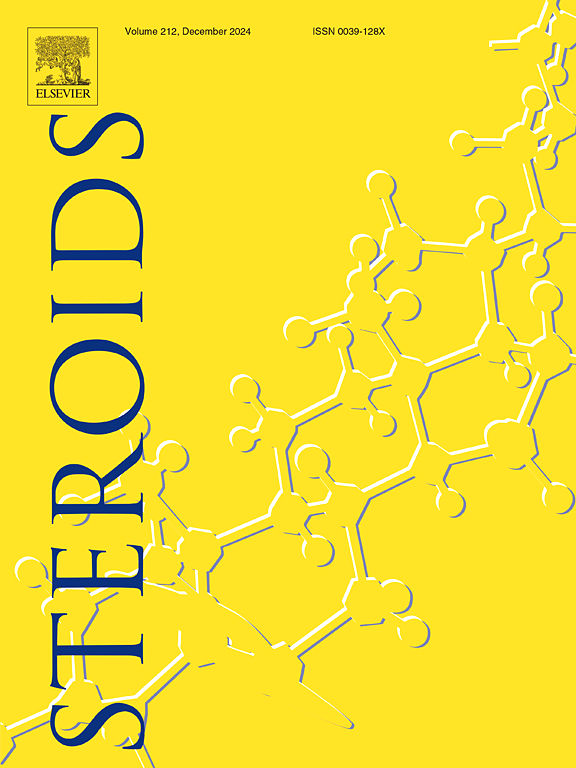Laetiporus sulphureus mushroom culture − source of secondary metabolites, and as a catalyst for biotransformation of breast cancer drug exemestane
IF 2.1
4区 医学
Q4 BIOCHEMISTRY & MOLECULAR BIOLOGY
引用次数: 0
Abstract
Certain mushrooms are used as low-calorie food supplements due to their excellent taste, and presence of a variety of essential vitamins, minerals and secondary metabolites. Some of them have therapeutic significance, and used in traditional medicines. Mushrooms cells can also be used as biocatalysts for the derivatization of organic compounds. During the current study, 3β-hydroxy-24-methylenelanost-8-en-21-oic acid (1) was isolated from Laetiporus sulphureus (Bull.) Murrill. The cell culture of the same mushroom was used for the biotransformation of breast cancer drug, exemestane (2) into a new analogue, 18-hydroxy-6-methylene-androsta-1,4-diene-3,17-dione (3). Compounds 1, and 3 were purified by using various chromatographic techniques, and their structures were determined with the help of 1D- and 2D-NMR, HREI-MS, and IR spectroscopic techniques. Since compound 1 also has a steroidal skeleton (like aromatase inhibiting drug exemestane (2)), the metabolite 1 was also evaluated for its aromatase inhibitory potential, along with a new transformed product 3. Aromatase plays a crucial role in estrogen biosynthesis, and therefore its inhibition is a key approach for the treatment of estrogen receptor-positive (ER+) breast cancers. Compounds 1 and 3 demonstrated a significant aromatase inhibition, with IC50 values of 590 ± 0.03 nM and 337.5 ± 0.01 nM, respectively, relative to exemestane’s IC50 of 210.0 ± 0.16 nM. Furthermore, in silico studies predicted that these inhibitors 1–3 were able to occupy the active site and interacted with catalytically important residues of the enzyme. While molecular dynamic simulation predicted the stability of aromatase- ligand complexes. The studies identified that metabolites 1 and 3 can serve as drug candidate after further development.
乳腺癌药物依西美坦的次生代谢物来源及生物转化催化剂。
目前,某些蘑菇被用作低热量的食品补充剂,因为它们的味道很好,而且含有各种必需的维生素、矿物质和次级代谢物。其中许多具有治疗意义,被用于传统药物中。蘑菇细胞也可以用作有机化合物衍生化的生物催化剂。本研究从硫酸Laetiporus sulureus (Bull.)中分离得到3β-羟基-24-亚甲基烯酸-8-烯-21-酸(1)。Murrill。该菌的细胞培养用于将乳腺癌药物依西美坦(2)转化为新的代谢物18-羟基-6-亚甲基- androta -1,4-二烯-3,17-二酮(3)。化合物1和3通过各种色谱技术纯化,并通过1D和2d nmr、HREI-MS和IR光谱技术对其结构进行了测定。由于化合物1也具有甾体骨架(如芳香化酶抑制药物依西美坦(2)),因此也评估了代谢物1及其新的转化产物3的芳香化酶抑制潜力。芳香化酶在雌激素的生物合成中起着至关重要的作用,抑制其成为治疗雌激素受体阳性(ER+)乳腺癌的关键治疗策略。化合物1和3展示了重要的芳香化酶抑制,与590年的IC50值 ±0.03 nM和337.5±0.01 nM,分别相对于依西美坦的IC50 210.0±0.16 nM。此外,硅研究预测这些抑制剂1-3能够占据活性位点并与催化重要残基相互作用。分子动力学模拟预测了芳香化酶-配体配合物的稳定性。研究发现,代谢物1和3在进一步开发后可作为候选药物。
本文章由计算机程序翻译,如有差异,请以英文原文为准。
求助全文
约1分钟内获得全文
求助全文
来源期刊

Steroids
医学-内分泌学与代谢
CiteScore
5.10
自引率
3.70%
发文量
120
审稿时长
73 days
期刊介绍:
STEROIDS is an international research journal devoted to studies on all chemical and biological aspects of steroidal moieties. The journal focuses on both experimental and theoretical studies on the biology, chemistry, biosynthesis, metabolism, molecular biology, physiology and pharmacology of steroids and other molecules that target or regulate steroid receptors. Manuscripts presenting clinical research related to steroids, steroid drug development, comparative endocrinology of steroid hormones, investigations on the mechanism of steroid action and steroid chemistry are all appropriate for submission for peer review. STEROIDS publishes both original research and timely reviews. For details concerning the preparation of manuscripts see Instructions to Authors, which is published in each issue of the journal.
 求助内容:
求助内容: 应助结果提醒方式:
应助结果提醒方式:


